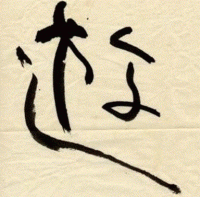There are two parts to chapter two of the Lao-tzu the first deals with ‘mutual arising’ the second deals with the use of the tao as a model for the sage. I want to focus on the first part.
We are presented with a series of ‘mutual arising’ claims – the beautiful and the ugly, good and bad, ease and difficulty, long and short, note and sound (as Lau points out the translation of this pair is tentative at best), and before and after.
The third pair we are presented with, however, seems to be the general case. In the Chinese it reads: 故有無相生; this is usually translated as Something and Nothing produce each other.
What I want to look at is the translation of 有 & 無 – ‘something’ and ‘nothing’. It seems to me that there are two different translations and the way we choose to do so has profound influence on our understanding of the text as a whole.
Option (1) we take 有 & 無 to mean ‘Something’ and ‘Nothing’; that is we take these terms to refer to ontological entities. In more modern language we might use the philosophical terms ‘Being’ and ‘Nothingness’.
Option (2) we take 有 & 無 to mean ‘to have’ and ‘not to have’; that is we take these terms as merely functional and not ontological at all.
If we go with option (1) then the ‘mutual arising’ of Chapter two has great metaphysical importance. It would fit with the idea that tao can be described as 無 ‘nothingness’; and from this ‘nothingness’ all ‘being’ 有 emerges. This would seem to fit well with Ch 1 and Ch 42 where the metaphysical role of the tao as involved in the cosmology of existence. It would also fit with the metaphysics of Buddhism and the ideas which became central to religious Taoism.
However it does not really explain the other ‘mutual arising’ examples given in chapter; the fact that 有 & 無 arise mutually does not give us any interpretative help with the notion of ‘good and bad’ arising mutually. After all both ‘good’ and ‘bad’ are states of ‘being’ and so both 有. The same is true of all the other examples; beauty and ugliness, short and long etc… are all ‘things’; none of them are on the side of ‘nothingness’. This makes the translation of 有 & 無 as ‘Something’ and ‘Nothing’ (or ‘Being’ and ‘Nothingness’) unattractive.
Option (2) resolves this problem, if we translate 有 & 無 as, ‘to have’ and ‘not to have’ then the other examples make perfect sense. If ‘having’ produces ‘not having’ then obviously ‘having beauty’ produces ‘not having beauty’, ‘having goodness’ obviously produces ‘not having goodness’. Thus this functional translation makes very good sense of the other examples.
However it does imply that the association of the tao with some ‘metaphysical’ notion of ‘nothingness’ is incorrect. Interestingly, while in the Lao-tzu we are told that the tao lacks many thing (no name wu-ming, no form wu-xing etc…), we are never explicitly told that the tao is ‘nothing’. The closest we get is in Ch42 with ‘the tao begets the one’ though even here that is far from explicit (moreover this chapters absence from the Guodian texts implies it is a late addition).
This may have some far-reaching implications. If we do translate 有 & 無 as merely ‘functional’ and not ‘metaphysical’ then, it seems to me we end up with a very different view of the Lao-tzu as a whole. To put is crudely it makes the text ‘referential’ to the world of ‘things’ very much in line with Confucian ideas; and undermines the ‘mystical’ reading which is central to religious Taoism and Chan Buddhism.

